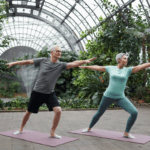Coming Soon: E-book about Kundalini Yoga - Sign up here to be among the first to get it!
Stepping into a yoga class, the **yoga crow pose** often stands out as a goal for many practitioners. This powerful arm balance is not just about physical strength; it’s a blend of focus, control, and mental clarity. Embarking on this journey, you’re set to master the essentials of crow and crane stances, comprehend their positive impacts on your physique and psyche, while confidently overcoming typical hurdles. Aiming to fortify your upper body or refine the equilibrium of your stance, getting a grip on the crow pose could revolutionize your yoga journey.
Our guide is brimming with actionable advice on utilizing tools to their fullest and seamlessly weaving this stance into your regimen for intricate sequences. Get ready to elevate your practice by unlocking one of yoga’s most iconic poses.
Table of Contents:
- Crow Pose and Crane Pose Basics
- Benefits of Practicing Yoga Crow Pose
- Step-by-Step Guide to Mastering Yoga Crow Pose
- Modifications and Props for Enhancing Your Practice
- Common Challenges in Yoga Crow Pose
- The Anatomy Behind Yoga Crow Pose
- Integrating Yoga Crow Pose into Your Routine
- Mindfulness While Practicing Yoga Crow Pose
- FAQs in Relation to Yoga Crow Pose
- Conclusion
Crow Pose and Crane Pose Basics
When diving into the world of yoga arm balances, understanding the difference between Bakasana (Crane) and Kakasana (Crow) is essential. Both poses demand balance, focus, and strength but differ slightly in form.
In Crow pose, your arms are bent with knees resting on upper arms near the elbows. This makes it a great starting point for those new to arm balances. On the other hand, Crane pose requires straight arms, pushing the limits of your arm strength and balance further.
Sanskrit Origins
Delving into the Sanskrit terminologies unveils the core nature and intent behind each of these carefully curated postures. “Bakasana” comes from “baka,” meaning crane; this asana mimics a crane’s poised elegance on its slender legs or here: straight arms. Meanwhile, “Kakasana,” deriving from “kaka” which means crow, reflects a more grounded stance akin to that of crows perched with bent limbs.
Both these foundational yoga asanas not only enrich our physical practice by building core muscles and improving balance but also connect us deeply with historical roots stretching back centuries in yogic traditions.
Benefits of Practicing Yoga Crow Pose
Crow pose offers multifaceted benefits beyond mere physicality – enhancing mental focus while strengthening upper body parts like wrists, forearms shoulder blades inner thighs, and engaging core muscles significantly. Incorporating tough poses like these not only ramps up your flexibility and muscle stamina but also elevates your general health.
Benefits of Practicing Yoga Crow Pose
Delving into the crow pose in yoga not only enhances equilibrium and fortifies muscles but also unfolds a plethora of advantages that ripple through one’s daily life. Engaging in this intricate arm balance not only fortifies your core and enhances upper body resilience but also emerges as a formidable enrichment to your yoga regimen.
The distinct architecture of the crow pose requires you to bear weight on your arms with knees resting on upper arms. It’s not just about arm strength but also finding that focal point where everything aligns perfectly. By regularly incorporating this asana into your routine, you’ll notice an enhancement in both physical stability and mental focus.
A key aspect often overlooked is how much this pose can bolster areas like the chest, hips, thighs alongside core and upper back strengthening. Both beginners and seasoned yoga asana practitioners find their threshold for letting go of fear increases as they become more accustomed to balancing their entire body weight on just two points of contact.
Fear of falling forward might seem daunting at first; however, using props such as foam blocks can offer support while building confidence in the pose. Additionally, exploring other poses that build strength and flexibility prepares your body further by enhancing shoulder distance awareness along with improving grip through fingers spread wide across the mat.
To sum up: practicing crow pose not only advances one’s physical capabilities by building muscular fortitude throughout various parts of the body but also enriches mental resilience through overcoming challenges posed during each attempt at achieving perfect balance.
Step-by-Step Guide to Mastering Yoga Crow Pose
How to Begin in Crow Pose
Finding the right starting position is crucial for crow pose. Begin by coming into a squat position, keeping your knees wide apart and bringing your hands flat on the ground shoulder distance away from each other. Spread your fingers as wide as possible to ensure a sturdy foundation. This precise hand placement is key as it lays the foundation for balancing on your hands.
To prepare yourself further, practice poses like garland pose which opens up your hips and strengthens your lower body, providing more ease when transitioning into crow pose.
Finding Stability and Balance
Balancing on hands requires distributing weight evenly through both palms. Start by shifting forward slowly until you feel most of your weight supported by your upper arms rather than just fingertips or wrists alone. Remember that arm strength plays a significant role here; if this feels challenging at first, incorporate exercises from Yoga Poses that Build Arm Strength into your routine to help build this necessary muscle power over time.
A common fear among yoga students practicing crow pose is falling forward due to lack of balance or stability. To overcome this hurdle without sacrificing safety, place a foam block in front of you as a precautionary measure while trying out the posture until confidence builds with practice.
Modifications and Props for Enhancing Your Practice
Finding your balance in crow pose can be a challenge, but using props (foam block) and trying modifications for beginners are great ways to get there. These tools not only help you achieve the posture but also deepen your practice over time.
Using Props (Foam Block)
If balancing on your hands seems like a distant dream, let’s start with something simple: a foam block. Placing it under your feet gives you that extra lift off the ground, making it easier to bring knees high onto upper arms. This small adjustment can make a big difference by allowing you to feel what it’s like to bear weight through your arms without going all-in just yet.
You’ll find more creative ideas on how props can transform arm balances here.
Modifications for Beginners
Starting from squat position might seem intimidating at first. So why not try elevating yourself? Place two blocks shoulder distance apart and grip them firmly with fingers spread wide. By lifting yourself slightly above the floor, maintaining balance becomes less about fighting gravity and more about finding alignment between hips high above shoulders.
Besides helping with height issues, this setup allows newbies to work on hand placement without stressing too much about falling forward—a common fear among yoga students practicing crow pose for the first time.
Incorporating these modifications into regular sessions gradually builds strength in core muscles and confidence in arm balances; essential elements as one progresses towards mastering crow pose fully unassisted.
Common Challenges in Yoga Crow Pose
Fear of Falling Forward
Many yoga students hesitate to fully commit to crow pose because they’re scared of tumbling forward. This fear is natural but can be managed with the right approach. Starting close to a wall or using a thick, cushioned mat for extra safety might help ease this anxiety. Practicing garland pose and slowly shifting your weight forward helps you get used to the sensation of leaning into your hands without falling.
A great tip is focusing on a fixed point ahead, known as a focal point, which stabilizes balance by concentrating your gaze. Additionally, engaging core muscles actively supports not just stability but also ensures that you control the descent if you start tipping over.
Lack of Arm Strength
If arm strength is what’s holding you back from mastering crow pose, integrating poses like plank and chaturanga into your routine will build up necessary muscle over time. Bear in mind that distributing weight evenly across both palms while spreading fingers wide helps reduce strain on any single part of the arm.
Incorporating exercises specifically targeting wrist flexors can also prepare them for bearing weight during practice thus minimizing discomfort or risk of carpal tunnel syndrome; warming up wrists before attempting crow pose makes them more pliable and less prone to injury.
Wrist Discomfort
Wrist discomfort often arises from improper hand placement or inadequate warm-up. To alleviate this issue, ensure hands are shoulder distance apart with fingers spread widely – this increases base support thereby reducing pressure on wrists. Incorporate wrist strengthening exercises and stretches into daily routines aids in making wrists stronger and more flexible over time hence mitigating potential pain points experienced during arm balances like crow pose.
Mastering crow pose starts with overcoming fear and building strength. Use a wall, focus your gaze, and engage your core to tackle the fear of falling. Boost arm and wrist strength through targeted exercises like plank, chaturanga, and wrist stretches to nail this challenging balance.
The Anatomy Behind Yoga Crow Pose
When we explore the anatomy involved in the yoga crow pose, we delve into a complex interaction of strength, flexibility, and balance. Engaging in this posture tests your bodily limits while simultaneously enriching different regions with its deep advantages.
Crow Pose and Its Impact on Your Body
Practicing crow pose significantly strengthens your wrists, arms, shoulders, inner thighs, and core muscles. Diving into the crow pose, you’re essentially hitting a full-body tune-up, activating various muscles all at once. The engagement of these areas helps mobilize the upper back and hips as well.
An often-overlooked aspect is its effect on wrist flexors which play a crucial role in maintaining balance and bearing weight during this pose. For those concerned about carpal tunnel syndrome or similar conditions affecting wrist health, using props for arm balances can offer additional support, reducing strain on vulnerable joints.
Beyond building physical strength, crow pose teaches us about our own body’s balance architecture — how shifting weight affects stability, how engaging certain muscles can create lift, and how focus directs energy. Additionally, it awakens the core by demanding rigorous contraction for ascension, proving itself a crucial drill for those aspiring to elevate their fitness panorama via yoga endeavors.
Incorporating this challenging yet rewarding posture into your routine promises more than just an improvement in arm strength; it invites you to confront fears—like falling forward—and develop strategies to overcome them by cultivating patience, breath control, and mindfulness. Embarking on the journey of crow pose not only bolsters our physical prowess but also deepens the bond between mind and spirit, guiding us towards conquering both seen and unseen territories with each practice.
Integrating Yoga Crow Pose into Your Routine
Making the crow pose a regular part of your yoga practice can significantly enhance both your physical and mental prowess. Mastering this arm equilibrium demands concentration, robustness, and steadiness, rendering it a perfect augmentation to your vinyasa sequence or as an intermediary stance.
To start integrating crow pose into your routine, begin by building up the necessary arm strength. A great way to do this is through poses that prepare you for the weight-bearing aspect of crow. Ponder adding to your daily regimen yoga positions such as variations of the plank or the more intricate chaturanga dandasana to fortify your arms.
Beyond just muscle power, achieving a stable crow pose demands keen body awareness and control over one’s center of gravity. Engaging in exercises that enhance equilibrium and activate your core can significantly contribute to your prowess. Poses such as garland (Malasana) encourage hip flexibility while simultaneously engaging the core muscles – essential components for mastering crow.
Finding Stability and Balance
Achieving stability in crow involves more than just physical readiness; it also hinges on breath mindfulness techniques which foster concentration during balancing acts. Engaging in practices that refine breath control helps anchor the mind amidst challenging postures thereby improving overall steadiness in balances including crow.
An often-overlooked factor when attempting arm balances like crow is wrist health due to its bearing nature on these joints. Before practicing make sure to warm up properly with gentle wrist stretches or exercises designed specifically for strengthening this area potentially mitigating discomfort from conditions such as carpal tunnel syndrome experienced by some practitioners during weight-bearing activities.
Mindfulness While Practicing Yoga Crow Pose
Mindful Breathing Techniques
When tackling the crow or crane poses, mindful practice and breath control techniques are your best allies. Deep, focused breathing not only helps maintain balance but also enhances your overall experience during these challenging arm balances. By paying attention to each inhale and exhale, you create a foundation of stability that supports both physical alignment and mental focus.
Incorporating a mindful approach into your yoga routine transcends just hitting the right positions; it fosters a deeper bond between physical form and mental state, enriching the entire experience. This connection is crucial in poses like the crow pose where precise muscle engagement is key. Activating your central muscles, all while maintaining a rhythmic breathing pattern, grants enhanced mastery of the stance.
To further explore how mindfulness can elevate your yoga routine, especially with arm balances such as the crow pose, consider reading 5 Yoga Poses That Build Strength and Flexibility. This resource offers insight into how strengthening exercises paired with mindful breathing pave the way for success in more advanced postures.
FAQs in Relation to Yoga Crow Pose
What is the crow pose good for?
Crow pose boosts your balance, strengthens your arms and core, and sharpens focus. It’s a full-body workout.
What is the trick to doing crow pose?
The key lies in leaning forward confidently while firmly planting your hands down. Balance follows courage here.
Is Crow pose difficult?
Yes, it challenges most beginners with its demand for strength, balance, and confidence all at once.
What is the difference between Crow pose and bakasana?
Bakasana refers specifically to Crane Pose; higher straight arms than Crow Pose which has bent elbows.
Conclusion
Mastering the yoga crow pose takes more than just physical strength; it’s about balance, focus, and persistence. Discovering the crow pose is key in developing not only your upper body but also enhancing core muscular fortitude. And remember, using props isn’t a sign of weakness but a step towards progress.
Practice makes perfect. Start with your hands flat and fingers spread wide on the mat to ensure stability. Keep trying even when you wobble or fall; each attempt brings you closer to success.
Fear of falling forward? It’s common but conquerable with patience and practice. Take a moment to breathe in and out slowly, helping you stay centered and steady.
Incorporate crow pose into your routine gradually, listen to your body’s warning voice, and soon enough, you’ll feel strong in your arm balances.
To wrap up: stay patient, be persistent, breathe deep. The journey through mastering yoga crow poses leads not only to physical achievements but also mental clarity and inner strength.
Sign up for our newsletter to stay updated with the latest articles, or ask me anything!



